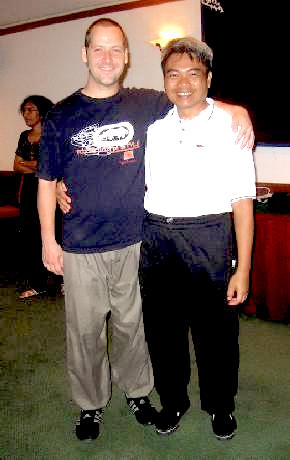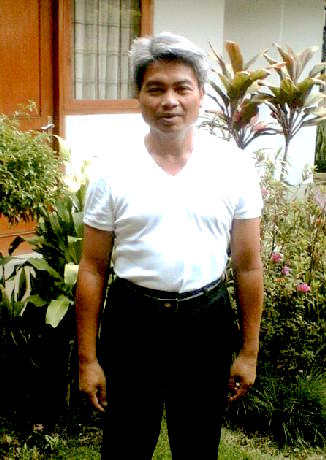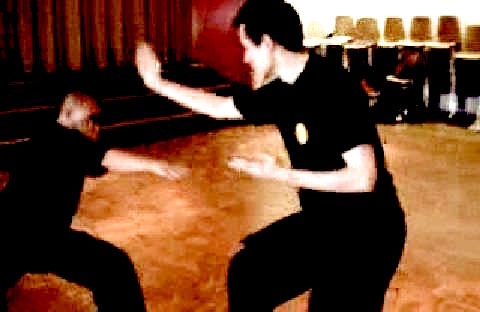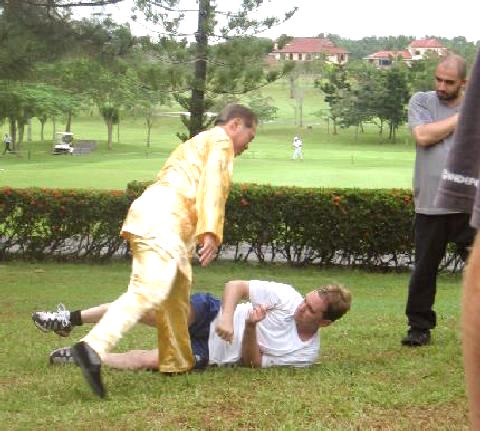February 2007 (Part 3)
SELECTION OF QUESTIONS AND ANSWERS


Two photographs of Sifu Joko Riyanto of Shaolin Wahnam Indonesia showing his waist line has been reduced within a month by practicing “Drawing the Moon”. In the first photograph, Sifu Joko poses with Sifu Roland Mastel of Shaolin Wahnam Switzerland.
Question 1
Although our Sigungs and other past Masters are no longer here, do they still watch over us? How can we become more receptive to their guidance?
— Dr Damian, Malaysia
Answer
Although our past masters, including my sifus, are no longer here physically, they are still with us — in our hearts, in our gratitude, in their teachings and in the Cosmos. Yes, they still watch over us, figuratively as well as realistically.
Figuratively they watch over us in our practice as well as daily activities. We remind ourselves of their greatness and generosity, and of their ideals which shape and influence the way we live our lives to be meaningful and rewarding. We remind ourselves that we are inheritors of a priceless legacy to which they made great contributions, and from which we benefit tremendously.
If I am to use just one term to describe their teachings, it is “clear-consciousness” from Sifu Ho Fatt Nam, and “righteousness” from Sifu Lai Chin Wah. The teachings of all the other past masters can be summed up in our Ten Shaolin Laws.
Realistically, many of us have received teachings in non-physical ways from your sigungs (or sitaigungs). On a few occasions my sifu, Sifu Lai Chin Wah, visited me in dreams to teach me what he did not teach me when he was here on earth.
During a recess in the UK Summer Camp of 2006, Darryl asked me to check his Monkey Set, which was a specialty of my sifu, Sifu Ho Fatt Nam. After showing him some fine points I left him to practice on his own. Darryl had some unsolved problems. In a moment of inspiration, he asked his Sigung Ho Fatt Nam for help, and the answers were flashed to him instantly.
Question 2
I am very happy to know that you will be here in Portugal to give an intensive seminar on Shaolin Kung Fu. I am interested in attending the seminar, and I have a question about the seminar. Is the seminar different from the intensive courses you offer in Malaysia. Since my current situation doesn't allow me to attend both this seminar and your intensive course in the near future, I am wondering if there are any great differences between the seminar here and the course in Malaysia.
— Miguel, Portugal
Answer
The seminar I give in Portugal as well as other countries like Spain and Switzerland is a regional Shaolin Kungfu Course, which is different in content and skill levels from those of the Intensive Shaolin Kungfu Courses I give in Malaysia, although the aims and nature of the courses are similar.
In a regional course I teach eight combat sequences, whereas in an intensive course I teach sixteen. The eight combat sequences are composed into a set called Single Tiger Emerges from Cave. In an intensive course the sixteen combat sequences are composed into four sets, namely Black Tiger Steals Heart, Fierce Tiger Speeds Through Valley, Happy Bird Hops up Branch, and Fell Tree with Roots.
Fundamental skills, like correct timing and spacing, and fluidity of movements, are taught in a regional course. The skill levels in an intensive course are higher, progressing to skills like pressing attacks and their counters, and avoiding opponents' strength and striking their weakness. The focus in a regional course is on good health and combat efficiency, whereas in an intensive course it includes and surpasses this, advancing to mind expansion and spiritual fulfilment.
The aims and the nature of the two different courses are similar. The two major aims of both courses are to enable participants to develop internal force, and to use kungfu forms in sparring. The nature of training is similar, which is based on direct experience as well as understanding the relevant philosophy so that participants can apply the skills and principles learnt in the course to other situations, not only in kungfu but also in life. For example, the ability to spar for more than an hour without panting will enable them to work longer and better in daily life, and the mental clarity in making the right decisions in combat situations will enable them to perform more efficiently in daily situations.
Question 3
I wanted to be in your chi kung classes when you came to USA, but I was not aware of your coming as I only recently purchased two of your books. Presently, I am doing “Lifting the Sky” and “Drawing the Moon” for obesity.
— Mark, USA
Answer
In our school “Lifting the Sky” is known as a wondrous exercise. It has a whole range of benefits from beginners to masters. It is easy to practice, and the benefits are quickly realized. When one follows the instructions respectively but still practices wrongly due to carelessness or forgetfulness, the side-effects are normally not serious. This is not the case in some exercise where side-effects can be very harmful.
“Drawing the Moon” (not to be confused with “Carrying the Moon” which is a different exercise) is an excellent exercise for reducing excessive mass around the abdomen. You can find some interesting discussion on this topic in the Shaolin Wahnam Discussion Forum. Please see the threads on Drawing the Moon: Is it a Myth? and Chi Kung and Fitness/Weight Loss. Sifu Joko Riyanto of Shaolin Wahnam Inodonesia has kindly provided photos showing that he reduced his waist line from 38 inches to 34 inches within a month of practicing this exercise without affecting his weight. But, as you can read from the discussions, it is important to practice it as a chi kung exercise.

Assistant Instructor Mauro of Shaolin Wahnam Switzerland and Assistant Instructor George of Shaolin Wahnam England free sparring during a regional Shaolin Kungfu course in Switzerland. You can view video clips of their free sparring here.
Question 4
I also have a stuttering problem. It started when I was 6 years old and now I am an adult. It is a speech disorder that consists of spasmodic speech, high level of anxiety and repetitions of words. I have a lack of self-confidence and high level of anxiety in general.
Are there any exercises that you would suggest I should do that could help me to overcome stuttering? I also need to do something about my lack of self confidence and anxiety.
Answer
From the chi kung perspective, your stuttering problem, lack of self confidence and feeling of anxiety are inter-related. These problems are related to the gall bladder and the stomach systems. While there are specific exercises to improve the gall bladder and the stomach systems, it is better to approach your problems in a holistic manner.
The “Alternative Mode of Flicking Fingers” is a good exercise to overcome these problems, but this is an advanced exercise and has to be taught by a qualified instructor. Hence, a more general approach of Self-Manifested Chi Movement is advisable for you. You can induce the self-manifested chi movement using any sets of chi kung exercise. You can also use “Lifting the Sky”.
Question 5
If there are chi kung exercises that could help with stuttering, is it okay to combine them with the above two exercises for obesity? If yes, how would I combine them? If no, how should I proceed?
Answer
The answer varies according to different persons and situations. Most persons today practice “Lifting the Sky” and “Drawing the Moon” not as chi kung but as gentle physical exercise. They still have benefits, though their beneifts are far less than those derived from practicing the exercises as chi kung. The benefits, if the exercises are practiced well as gentle physical exercise, are good posture, slimmer waist line and general well being, but these would not enable you to overcome your problems of stuttering, self confidence and anxiety.
So you would have to practice chi kung exercises that help you to overcome your particular problems. There are many chi kung exercises that can overcome your problems, and you can combine them with “Lifting the Sky” and “Carrying the Moon” in any way you like. In your case, the class of chi kung exercises called “Self-Manifested Chi Movement” is recommended. As mentioned earlier, any sets of chi kung exercises can induce self-manifested chi movement.
Your problem is not what exercises to practice, but how to practice any one exercise as chi kung. This statement is straight-forward and addresses your problem directly, but to you as well as to many other people, the statement may not make any sense. The main reason is because you and the many other people do not know what practicing chi kung really is — although they may have been practicing chi kung techniques for years but as gentle physical exercise.
Some of them (but not you) would accuse me as being boastful, saying that I imply only the chi kung taught in Shaolin Wahnam is genuine and all other schools of chi kung are false. This accusation is of course not true. We in Shaolin Wahnam know that there are other genuine chi kung masters and genuine chi kung schools. This is another issue. The issue here is that a great majority of chi kung practitioners today actually practice gentle physical exercise but mistake it as chi kung.
Let me give you an analogy. Suppose you want to drive to New York and you have a few cars but you do not know how to drive. You ask which car should you drive. But whatever the answer is, you would not reach your destination. Your problem is not which car to drive, but how you can successfully drive any car. This is not a very good analogy but it shows the point I am making. In the analogy, the destination is overcoming your problems, and the cars are the chi kung exercises.
If you were very skillful in chi kung, you could overcome your problems of stuttering, lack of confidence, anxiety as well as obesity by practicing just any one chi kung exercise, including just practicing “Lifting the Sky” or just “Drawing the Moon”! Again as an analogy, if you were very skillful in selling, you could overcome any economic problems by selling just any one thing, including just selling cars or just selling pencils. But not everyone is very skillful. So certain exercises may be more cost-effective for overcoming your problems. But first of all you must learn genuine chi kung.
Question 6
How was Zui Ba Xian Quan (Drunken Eight Immortals Set) in Wing Choon?
— Marek, Poland
Answer
The kungfu set “Zui Ba Xian” or “Drunken Eight Immortals” is found in Choe Family Wing Choon, but I don't think it is found in Yip Mann Wing Choon or other versions of Wing Choon Kungfu.
This was because the master who taught Wing Choon Kungfu to the Choe Family was originally a Choy Li Fatt Kungfu master, and “Drunken Eight Immortals” came from Choy-Li-Fatt. This master was Yik Kam.
One day a “red-boat”, i.e. a huge boat carrying an opera troupe to various places for performance, landed at the Nga Wu Village (which means Beautiful-Lake Village) in the Phoon Yu District of South China where the Choe Family stayed. On the “red-boat” was Leong Yi Tai, who was one of the two inner-chamber disciples of Leong Phok Phow, the husband of Yim Wing Choon. (The other inner-chamber disciple was Wong Wah Poh, the master who transmitted Wing Choon Kungfu to Yip Mann's lineage.)
Yik Kam heard about the amazing kungfu ability of Leong Yi Tai. So he invited the Wing Choon master to a sumptuous dinner and requested for a kungfu demonstration. When Leong Yi Tai showed his best kungfu set, “Siu Lin Tou” which means “Little Beginning”, Yik Kam was not impressed. He wondered how could such a simple looking set be used for fighting.
A friendly sparring session followed. Yik Kam, who was a remarkable fighter himself, was repeatedly and convincingly defeated. In the end he begged Leong Yi Tai to accept him as a student.
Hence we in Choe Family Wing Choon are very lucky to have both Choy-Li-Fatt Kungfu as well as Wing Choon Kungfu in our system. These two kungfu styles complement each other excellently. Choy-Li-Fatt's forte is in mass combat and its relative weakness is high-level individual fighting. Wing Choon Kungfu is the opposite, its forte is in individual fighting and its relative weakness in mass combat.
Choe Family Wing Choon is rich in kungfu sets. “Drunken Eight Immortals” and another set straight-forwardly called “Choy-Li-Fatt” have typical Choy-Li-Fatt forms and principles. Sets like “Battle Palm” and “Essence of Fighting” have Choy-Li-Fatt forms but Wing Choon principles. “Siu Lin Tou” has both Wing Choon forms and principles. “Fa Khuen” or “Flower Set” has Shaolin forms and Wing Choon principles.
I believe “Fa Khuen” was the set Yim Wing Choon learned from her teacher, Ng Mui, and it was from “Fa Khuen” that Yim Wing Choon took techniques and skills for her specialized training every morning. Over time these selected techniques and skills were formulated into a routine which she would practice first before other aspects of kungfu. When asked what this routine or set was called, she answered “Siu Lin Tou”, which means “some little practice to start my training”.

Grandmaster Wong demonstrates using only his shoulder to fell an opponent during an Intensive Shaolin Kungfu Course in Malaysia
Question 7
How does “Drunken Eight Immortals” use the central line and other Wing Choon principles?
Answer
Compared to other sets in Choe Family Wing Choon, “Drunken Eight Immortals” employs Choy-Li-Fatt forms and principles. This and another set called “Choy-Li-Fatt” excellently remind us in Choe Family Wing Choon of our early Choy-Li-Fatt connection.
While many other Wing Choon practitioners seem to regard the central line principle as focusing the attack on an opponent's mid point, in Choe Family Wing Choon this principle is given a wider interpretation.
While attacking an opponent's mid-point is employed if desirable, the focus is more on avoiding the opponent's mid-point attacks and counter-attacking him from the sides. For example, if the opponent attacks with a powerful right middle thrust punch, instead of blocking the punch with the left mirror-hand from inside out and simultaneously thrusting the right palm at his throat as some proponents of the central line principle would do, in Choe Family Wing Choon a more preferred response would be to deflect the right punch with the left palm from outside in (that is deflecting it according to its punching momentum, instead of blocking it against its momentum) and simultaneously driving a right phoenix-eye fist to his ribs or solar plexus. Such a response is typical of the forms and principles in “Siu Lin Tou” and “Fa Khuen”.
If a Choe Family Wing Choon practitioner wishes to use the mirror-hand cum palm thrust in this counter, he would implement it from outside in instead of from inside out. In other words, he would deflect the opponent's right middle thrust punch with his right mirror-hand from outside in following the punching momentum, and thrust his left palm at the opponent's throat from the left side to the centre line.
Both practitioners use the central line principle, but their approaches are different. The other practitioner uses the central line to attack his opponent, but the Choe Family practitioner avoids the central line attacks of his opponent and counter-attack from the side.
Does this Choe Family counter contradict another important Wing Choon principle, that of economy of movement, if it attacks from a side instead of from the centre? No, in fact it enhances this principle.
Although the attack travels from a side, it also travels the shortest distance from source to target. Suppose the target is at the north. The other counter travels in a straight line from south to north, whereas the Choe Family counter travels in a straight line from south-west to the north. But by shifting diagonally forward to the side, the distance from south-west is actually shorter than from the south.
The Choe Family counter employs another important Wing Choon principle, namely “using soft to defeat hard”, whereas in this case the other counter employs the principle of “using hard to subdue soft”. Deflecting away a right thrust punch with a left slap palm or with a right mirror-hand is following the momentum of the attack. Hence less force is needed to deflect a powerful punch. But blocking the punch with a left-mirror hand is going against the attacking momentum. Hence more force is required.
Such counters are not typical of a practitioner using the Drunken Eight Immortals Set. If an opponent attacks him with a right middle thrust punch, he would typically slant his body diagonally to his left side as if he were to fall like a drunken person, and simultaneously hang his right arm in an arc from the left via the top to the right onto the attacker's arm.
He employs the central line principle in the Choe Family manner, but does not employ the typical Wing Choon principles of “economy of movement” and “using soft to defeat hard”. In fact, he employs the principles of “using hard to subdue soft” and “using circles to overcome straight lines”, which are typical of Choy-Li-Fatt Kungfu. His arm must be powerful for his counter to be effective. This counter, therefore, is not suitable for a small-size person.
If the opponent moves away to avoid his counter-attack, he would launch forward like a drunken person and swing a “horn-punch” in an arch at the opponent's face. This is another characteristic Choy-Li-Fatt technique. A Wing Choon practitioner normally would not do this.
Question 8
Did you learn all the weapons in Choe Family Wing Choon?
Answer
There are many weapons in Choe Family Wing Choon. They include the Long Staff and the Butterfly Knives, which are found in other Wing Choon styles, as well as the Single Knife, the Short Staff, the Spear, the Kwan Do, the Big Trident and the Kungfu Bench, which are often not found in other Wing Choon styles.
I only learned the famous Six-and-a-Half-Point Staff, the Human-Character Butterfly Knives and the Thirteen-Technique Spear from my Wing Choon master, Sifu Choe Hoong Choy.
LINKS
Selected Reading
- Stances: Foundation for Internal Force and Combat Efficiency
- Scenic Views of Ireland — Guinness Attractions
- Two Big Secrets in Single Tiger Emerges from Cave
- Free Sparring using Kungfu Patterns after just 3 Days of Training
- In Search of Kungfu Secrets
